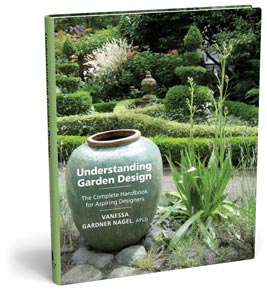Understanding Garden Design
I'm fascinated by garden design concepts but do not actually understand them. The first class I took 25 years ago helped me get the basic plant the tall things in the back bit, but most tips in the general gardening books seem outside my reach.
"Understanding Garden Design" was written by a former interior designer, Vanessa Gardner Nagel, APLD who took a different approach than other authors.
Nagle's approach starts at the beginning: establishing the reasons for designing at all instead of plopping plants in the ground willy-nilly. (my note: Many gardeners stick shrubs here and there without an eye to what that soon-to- be 6-by-10-foot viburnum will add to the landscape.)
"Planning precedes design. It is the time to prepare for design..." The chapter discusses what to consider, including your budget and sustainability. Allow 6-weeks of planning before gathering tools.
The next chapter helps you assess and document the site: Challenges, existing perennial plantings, home style, slope, microclimates, utilities, and neighbors.
Components, chapter 3 asks your family to list its requirements and desires: needs and wants. Rain garden, vegetable patch, fruit arbors, cistern, playground, pond, pets, meditation space, entertaining, greenhouse,laundry etc.
Next comes a chapter on how to prioritize what you discovered in the first 3 chapters.
Then, "Design 101" in chapter 5. Basic design includes color, line, shape, form, space, proportion, mass, focal point, repetition and rhythm, movement, sequence, texture, variety, contrast, balance and unity. (This is my weakest link and why I tend to have more of a cottage garden than a landscaped space. I'll re-read this before spring planning/planting begins!)
Finishes and Furnishings make up chapter 6 - furniture and accessories - the things we buy on impulse while traveling and shopping but probably should not.
Watering methods, conservation and irrigation budget make up chapter 7. Yes, we would all love to have a waterfall, in-ground sprinkler systems, pools, ponds, etc. But, there are alternatives.
Then the place where most of us begin: "Plants: A Structural Perspective". By following the first 7 chapters, your plant selection will be easier. Tall and upright or short and large around will fit into the plan you made.
Garden Lighting, chapter 9, addresses safety and security as well as ambience. Grazing, Silhoueting, Thrown shadow, Sparkle treatment, Underwater lighting, etc.
Chapter 10, "The Final Design" helps you stand back and review your design before the contractors arrive or your family begins the construction projects.
"Construction: Working with Contractors" will be valuable if you plan to hire out the projects in your plan. How to screen, bid, review bids and read the contract is followed by site prep, excavation, underground work, hardscape, etc. Chapter 11 will save you headaches.
Art in the garden, chapter 12, will teach restraint as you consider table placement, garden party settings, and maintenance. Less is more in most gardens.
"Understanding Garden Design: The Complete Handbook for Aspiring Designers" (and homeowners!)
236 pages, 8 by 10 hardcover,
List price $35 and $19 at online booksellers. Published 2010 by Timber Press
"Understanding Garden Design" was written by a former interior designer, Vanessa Gardner Nagel, APLD who took a different approach than other authors.
Nagle's approach starts at the beginning: establishing the reasons for designing at all instead of plopping plants in the ground willy-nilly. (my note: Many gardeners stick shrubs here and there without an eye to what that soon-to- be 6-by-10-foot viburnum will add to the landscape.)
"Planning precedes design. It is the time to prepare for design..." The chapter discusses what to consider, including your budget and sustainability. Allow 6-weeks of planning before gathering tools.
The next chapter helps you assess and document the site: Challenges, existing perennial plantings, home style, slope, microclimates, utilities, and neighbors.
Components, chapter 3 asks your family to list its requirements and desires: needs and wants. Rain garden, vegetable patch, fruit arbors, cistern, playground, pond, pets, meditation space, entertaining, greenhouse,laundry etc.
 |
| Vanessa Gardner Nagel's blog - link here |
Then, "Design 101" in chapter 5. Basic design includes color, line, shape, form, space, proportion, mass, focal point, repetition and rhythm, movement, sequence, texture, variety, contrast, balance and unity. (This is my weakest link and why I tend to have more of a cottage garden than a landscaped space. I'll re-read this before spring planning/planting begins!)
Finishes and Furnishings make up chapter 6 - furniture and accessories - the things we buy on impulse while traveling and shopping but probably should not.
Watering methods, conservation and irrigation budget make up chapter 7. Yes, we would all love to have a waterfall, in-ground sprinkler systems, pools, ponds, etc. But, there are alternatives.
Then the place where most of us begin: "Plants: A Structural Perspective". By following the first 7 chapters, your plant selection will be easier. Tall and upright or short and large around will fit into the plan you made.
Garden Lighting, chapter 9, addresses safety and security as well as ambience. Grazing, Silhoueting, Thrown shadow, Sparkle treatment, Underwater lighting, etc.
Chapter 10, "The Final Design" helps you stand back and review your design before the contractors arrive or your family begins the construction projects.
"Construction: Working with Contractors" will be valuable if you plan to hire out the projects in your plan. How to screen, bid, review bids and read the contract is followed by site prep, excavation, underground work, hardscape, etc. Chapter 11 will save you headaches.
Art in the garden, chapter 12, will teach restraint as you consider table placement, garden party settings, and maintenance. Less is more in most gardens.
"Understanding Garden Design: The Complete Handbook for Aspiring Designers" (and homeowners!)
236 pages, 8 by 10 hardcover,
List price $35 and $19 at online booksellers. Published 2010 by Timber Press



Comments